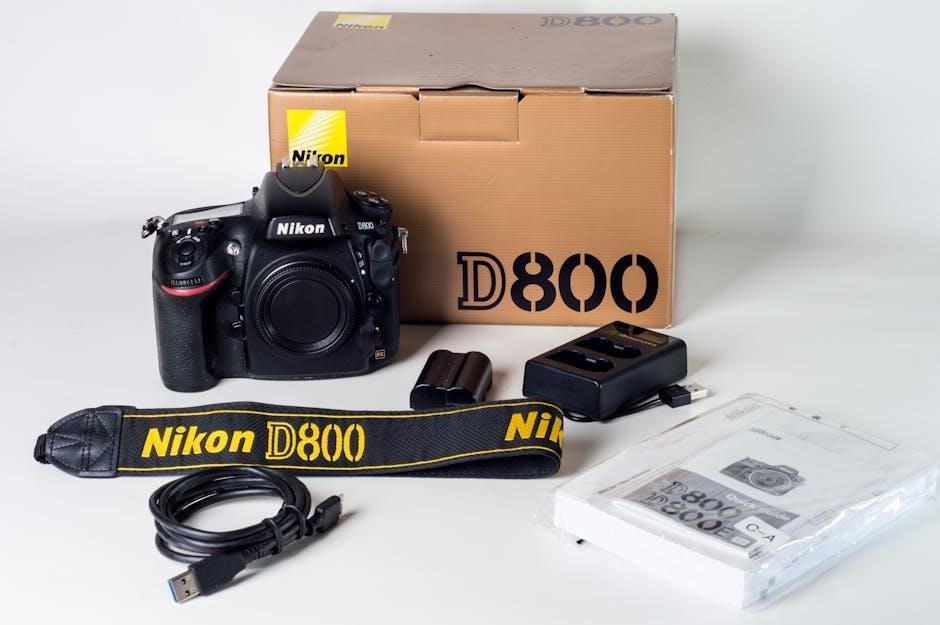Welcome to the APC Back-UPS XS 1500 user manual. This guide provides essential information for safe installation, operation, and maintenance of your 1500VA UPS system.
1.1 Overview of the APC XS 1500 UPS
The APC Back-UPS XS 1500 is a reliable uninterruptible power supply (UPS) designed to provide backup power and surge protection for critical electronics. With a capacity of 1500VA and 865W, it ensures uninterrupted operation during power outages. The UPS features a rated power of 865W, input voltage of 120V, and output connections via 5 NEMA 5-15R outlets. It supports indoor use and is compatible with APC’s PowerChute Personal Edition software for advanced power management. This unit is ideal for protecting computers, networking devices, and other sensitive equipment from power disruptions.
1.2 Importance of Reading the User Manual
Reading the APC XS 1500 user manual is crucial for safe and effective use of your UPS. It provides detailed guidance on installation, operation, and maintenance, ensuring optimal performance and longevity. The manual outlines essential safety precautions, proper handling, and troubleshooting steps to prevent errors and potential hazards. By understanding the features and specifications, users can maximize the device’s capabilities and resolve issues efficiently. This comprehensive guide is indispensable for both novice and experienced users, offering clear instructions to ensure reliable power protection for your critical equipment.

Safety Precautions
Ensure safe operation by following guidelines to prevent hazards. Avoid direct sunlight, excessive heat, and moisture exposure to maintain optimal performance and prevent potential damage.
2.1 General Safety Guidelines
To ensure safe and reliable operation of the APC Back-UPS XS 1500, follow these guidelines:
- Avoid installing the UPS in direct sunlight, excessive heat, or moisture.
- Do not expose the unit to temperatures below 32°F (0°C) or above 104°F (40°C).
- Ensure proper ventilation to prevent overheating.
- Keep the UPS away from conductive materials that could cause short circuits.
- Handle the battery carefully to avoid damage or leakage.
Always adhere to these precautions to maintain safety and optimal performance.
2.2 Proper Handling and Installation
Unpack the APC Back-UPS XS 1500 carefully and inspect for damage. Ensure all components, including the UPS, cables, and manuals, are included. Choose a stable, flat surface for installation, away from direct sunlight and moisture. Avoid areas with extreme temperatures or humidity. Mount the UPS securely to prevent movement during operation. For optional external battery packs, ensure proper placement and connection as outlined in the manual. Always follow the installation steps carefully to ensure safe and efficient operation. Refer to the manual for detailed installation instructions and guidelines. Proper handling ensures reliability and longevity of the UPS system.

Installation and Setup
Begin by unpacking and inventorying all components. Choose a suitable location for the UPS, ensuring proper ventilation and accessibility. Follow the step-by-step setup guide for initial configuration.
3.1 Unpacking and Inventory
Start by carefully unpacking the APC Back-UPS XS 1500 from its box. Verify all components are included, such as the UPS unit, power cord, USB cable, and user manual. Ensure no damage occurred during shipping. Check for any signs of tampering or physical defects. It’s crucial to account for all items to ensure proper installation and functionality. If any parts are missing or damaged, contact APC support immediately for assistance. This step ensures a smooth setup process and prevents potential issues down the line.
3.2 Choosing the Right Location
Selecting the right location for your APC Back-UPS XS 1500 is crucial for optimal performance and safety. Ensure the area is cool, dry, and well-ventilated to prevent overheating. Avoid direct sunlight and excessive moisture to maintain reliability. Place the UPS on a sturdy, flat surface that can support its weight, along with any external battery packs. Keep it away from flammable materials and potential hazards. Ensure good airflow around the unit to prevent thermal issues. Choosing the right location ensures longevity and reliable operation of your UPS system.
3.3 Mounting and Placement
For proper mounting and placement of your APC Back-UPS XS 1500, ensure it is installed on a stable surface. Avoid areas exposed to direct sunlight, moisture, or extreme temperatures. Use the provided hardware to secure the UPS if mounting on a wall or rack. Maintain at least 2 inches of clearance around the unit for adequate airflow; Ensure all cables are neatly organized to prevent tripping hazards. Proper placement enhances safety, performance, and accessibility, ensuring your UPS operates efficiently and reliably under various conditions. Follow all guidelines to maximize the lifespan of your device. Always refer to the manual for specific installation instructions.

Electrical Connections
Connect the APC XS 1500 to a 120V power source using NEMA outlets. Use the provided USB cable for computer integration, monitoring, and configure advanced settings.
4.1 Input Connection Requirements
The APC XS 1500 requires a 120V AC input power source. Use a NEMA-compatible outlet for connection. Ensure the UPS is placed indoors, away from direct sunlight and excessive heat. The unit supports optional external 24-volt battery packs for extended runtime. Connect the UPS to a sturdy, dedicated circuit to handle the electrical load safely. Avoid overloading the circuit to maintain optimal performance. Always follow local electrical codes and regulations when making connections; Proper grounding is essential to ensure safe operation and prevent potential hazards.
4;2 Output Connection Options
The APC XS 1500 provides five NEMA 5-15R output receptacles for connecting critical devices. These outlets deliver uninterrupted power during outages. Ensure loads are distributed evenly across the outlets to avoid overloading. The UPS supports surge protection and voltage regulation for connected equipment. For battery backup mode, prioritize essential devices to maximize runtime. Use the provided USB and RJ-45 ports for data communication and management. Always refer to the technical specifications for detailed output ratings and compatibility guidelines. Proper load management ensures optimal performance and longevity of the UPS system.
4.3 Connecting External Battery Packs
To extend runtime, connect APC’s optional BR24BP external 24-volt battery pack to the Back-UPS RS/XS 1500. This connection is compatible with Back-UPS RS models only. Use the supplied cable to link the battery pack to the UPS. Ensure the battery pack is fully charged before connecting. Avoid mixing old and new batteries to maintain reliability. The external battery pack increases backup capacity, supporting critical loads during extended power outages. Always turn off the UPS before connecting external batteries to ensure safe installation and operation. Follow the manufacturer’s guidelines for proper connection and maintenance of the battery pack.

Integration with Other Products
The APC XS 1500 seamlessly integrates with computers, networks, and APC software for enhanced monitoring and control, ensuring optimal performance and reliability in various applications.
5.1 Connecting to a Computer
To connect the APC XS 1500 to your computer, use the provided USB cable. Plug one end into the UPS’s USB port and the other into your computer. Install the PowerChute Personal Edition software from the CD or download it from APC’s website. This software allows you to monitor the UPS, configure shutdown settings, and receive notifications. Ensure your computer recognizes the UPS for seamless communication. The connection enables automatic file saving and system shutdown during power failures, protecting your data and hardware. This integration is compatible with both Windows and Mac operating systems.
5.2 Using the USB and RJ-45 Ports
The APC XS 1500 features USB and RJ-45 ports for enhanced connectivity. The USB port connects to your computer, enabling PowerChute software to monitor and control the UPS. The RJ-45 port supports network integration, allowing remote monitoring and management. Use the provided USB cable for a secure connection. Ensure the ports are clean and free from damage to maintain optimal performance. These ports enable advanced features like automatic shutdown and real-time updates, ensuring your system stays protected and efficient. Proper usage of these ports maximizes the UPS’s functionality and safeguards your equipment.
5.3 Compatibility with APC Software
The APC XS 1500 is compatible with PowerChute Personal Edition software, ensuring seamless integration with your computer. This software allows automatic file saving and system shutdown during power failures. It provides real-time monitoring, customizable settings, and detailed event logging. Use the USB port to connect the UPS to your computer and install the PowerChute software from the provided CD or APC’s official website. Compatibility ensures enhanced functionality, protecting your data and equipment effectively. Regular software updates are recommended to maintain optimal performance and security. This integration enhances the overall user experience and system reliability.
Operation Modes
The APC XS 1500 operates in normal mode, battery backup mode, and shutdown/restart mode. Each mode ensures reliable power delivery and system protection during different scenarios.
6.1 Normal Operation
In normal operation, the APC XS 1500 provides stable AC power to connected devices. The UPS operates when utility power is present, charging the battery and ensuring readiness for power interruptions. During this mode, the unit monitors input voltage and switches to battery power if irregularities are detected; Normal operation is indicated by LED status lights, confirming the system is functioning correctly and prepared to protect your equipment from power failures. This mode ensures efficient battery charging and continuous power delivery, safeguarding your devices during standard operating conditions. The UPS remains in this mode until a power issue triggers backup operation.
6.2 Battery Backup Mode
The APC XS 1500 enters Battery Backup Mode during a power outage or significant voltage fluctuation. In this mode, the UPS switches to battery power, ensuring uninterrupted operation for connected devices. The transition from AC to battery power is seamless, protecting equipment from surges and spikes. Battery Backup Mode is indicated by LED status lights, signaling active battery operation. The system provides a runtime of approximately 10 minutes at half load, allowing time for graceful shutdown or generator startup. This mode prioritizes safeguarding critical data and equipment during power interruptions, ensuring reliability and stability until primary power is restored or the battery depletes. Always monitor battery health to maintain optimal performance.
6.3 Shutdown and Restart Procedures
Proper shutdown and restart of the APC XS 1500 ensure safe operation and prevent data loss. To shut down, disconnect non-essential devices, then press and hold the power button until the UPS powers off. For restart, ensure the input power is stable and all cables are securely connected. The UPS will automatically resume operation in normal mode. If using PowerChute software, configure automatic shutdown settings for unattended operation. Always allow the battery to fully discharge before restarting after a prolonged outage. Follow these steps to maintain system integrity and reliability. Regular shutdowns help extend battery life and overall performance.

Power Management Software
The APC PowerChute Personal Edition software enables automatic shutdown and file saving during power failures, ensuring data protection and system integrity for your XS 1500 UPS.
7.1 Overview of PowerChute Personal Edition
PowerChute Personal Edition is a comprehensive power management software designed for APC Back-UPS systems, including the XS 1500. It provides advanced features to monitor and control your UPS, ensuring seamless power protection. The software automatically saves open files and shuts down your computer during extended power outages, preventing data loss. Compatible with Windows and macOS, PowerChute offers customizable settings for shutdown preferences, notifications, and power event logging. It also displays real-time power status and battery health, helping you manage your backup power effectively. The software can be installed via CD or downloaded from the APC website, ensuring easy setup and integration with your XS 1500 UPS.
7.2 Installing and Configuring the Software
Installing PowerChute Personal Edition is straightforward. Insert the CD provided with your APC XS 1500 or download the software from the APC website. Follow on-screen instructions to install the program. Once installed, connect your UPS to the computer using the USB cable. Launch PowerChute and configure settings such as shutdown preferences, notification alerts, and battery thresholds. Customize the software to suit your needs, ensuring automatic file saving and scheduled shutdowns during power failures. This setup ensures optimal protection for your equipment and data, leveraging the full capabilities of your XS 1500 UPS system.
7.3 Customizing Shutdown Settings
Customize shutdown settings in PowerChute Personal Edition to tailor your UPS response to power failures. Access the software preferences to set shutdown delays, enabling your system to wait for a specified duration before shutting down. Configure notifications to alert you of low battery levels or other critical events. Define battery thresholds to trigger shutdown when capacity drops below a certain percentage, ensuring data integrity. These settings allow you to balance system protection with operational needs, providing a seamless experience during power interruptions. Adjustments can be made to suit your specific requirements, enhancing the reliability of your APC XS 1500 UPS system.

Monitoring and Maintenance
Regular monitoring ensures optimal performance. Check battery health, update firmware, and perform routine maintenance tasks as outlined in the user manual. This ensures reliability and longevity.
8.1 Checking Battery Health
Regularly monitoring the battery health of your APC XS 1500 is crucial for ensuring reliable power backup. The UPS features built-in indicators and software tools to assess battery condition. Use the PowerChute Personal Edition software to view detailed battery status, including charge levels and estimated runtime. Additionally, the UPS provides visual and audible alerts for battery issues. Perform periodic battery tests as outlined in the manual to identify degradation or faults. Replace the battery promptly if it fails self-tests or shows signs of wear. Proper maintenance ensures your system remains ready for power outages.
8.2 Updating Firmware
To ensure optimal performance and access to new features, regularly update the firmware of your APC XS 1500. Use the PowerChute Personal Edition software to check for and install the latest firmware versions. Connect the UPS to your computer via USB or RJ-45, then launch the software. Follow the on-screen instructions to download and apply updates. Firmware updates enhance functionality, improve compatibility, and address potential issues. Always complete the update process without interrupting the power supply to avoid corruption. Keep your UPS up-to-date to maintain peak performance and reliability during power outages.
8.3 Performing Regular Maintenance
Regular maintenance ensures your APC XS 1500 operates efficiently and reliably. Inspect the UPS and cables for damage or wear. Clean the unit with a soft cloth, avoiding harsh chemicals. Check battery terminals for secure connections and corrosion. Verify the environmental operating range (0-40°C and 32-104°F) is maintained. Avoid exposure to direct sunlight or excessive moisture. Perform these checks every 6 months to prevent unexpected shutdowns and ensure optimal performance. Refer to the user manual for detailed maintenance procedures and safety guidelines to extend the lifespan of your UPS. Regular upkeep guarantees consistent power protection for your connected devices.

Troubleshooting Common Issues
Identify and resolve common issues like error indicators, power supply problems, or communication faults. Refer to the manual for step-by-step solutions and ensure optimal UPS performance.
9.1 Identifying Error Indicators
Understand and address error indicators on your APC XS 1500. The Building Wiring Fault (red) light signals potential shock hazards. Check connections and ensure proper installation. Other indicators may include overload or battery issues. Refer to the manual for detailed explanations of each LED status. Regularly inspect the UPS for warning signs to prevent operational disruptions. If issues persist, consult troubleshooting guides or contact APC support for assistance. Proper identification of error indicators ensures timely resolution and maintains system reliability.
9.2 Resolving Power Supply Problems
Address power supply issues with your APC XS 1500 by first checking the input voltage and ensuring all connections are secure. Verify that the UPS is properly plugged into a functioning outlet. If the Building Wiring Fault indicator is lit, inspect your home’s electrical system for issues. Avoid overloading the UPS, as this can trigger shutdowns. For persistent problems, consult the troubleshooting section or contact APC support. Regular maintenance, such as updating firmware, can also help prevent power-related issues. Always refer to the user manual for specific guidance on resolving power supply concerns effectively.
9.3 Fixing Communication Issues
To resolve communication issues with your APC XS 1500, first ensure the USB or RJ-45 cable is securely connected to both the UPS and your computer. Restart the UPS and restart your computer to re-establish the connection. If using PowerChute software, verify it is properly installed and updated. Check for loose or damaged cables and replace them if necessary. Ensure the UPS is correctly recognized by your operating system. If problems persist, disconnect and reconnect the UPS to reset communication. For advanced troubleshooting, refer to the APC support website or contact their technical team for assistance.

Technical Specifications
The APC XS 1500 features an input voltage of 120V, rated power of 865W, and 1500VA capacity. It includes a lead-acid battery and operates within 32-104°F (0-40°C).
10.1 Input and Output Ratings
The APC XS 1500 operates with an input voltage of 120V and provides a rated power of 865W. The output connection type is 5 NEMA 5-15R outlets, ensuring compatibility with standard devices. The UPS supports a maximum load of 1500VA, making it suitable for critical equipment. Input connection is via a NEMA 5-15P plug, and the unit delivers stable power during voltage fluctuations. These specifications ensure reliable performance for both home and office environments, safeguarding electronic devices from power disruptions.
10.2 Battery Specifications
The APC XS 1500 features a 24V lead-acid battery, designed to provide reliable backup power during outages. The battery typically charges within 8 hours and offers a runtime of approximately 1.5 minutes at full load. For extended runtime, an optional external battery pack (BR24BP) can be connected. The unit operates within an environmental range of 0–40°C (32–104°F). Regular battery health checks are essential, and replacement batteries are available from APC. The battery ensures seamless power delivery, safeguarding connected devices from sudden shutdowns.
10.4 Environmental Operating Range
The APC XS 1500 operates within a temperature range of 0–40°C (32–104°F) and a relative humidity of 0–95%, non-condensing. It is designed for indoor use only and should be placed on a stable surface to ensure proper ventilation. The UPS can function at altitudes up to 3,000 meters without performance degradation. Adhering to these environmental guidelines ensures optimal performance and longevity of the unit. Avoid exposing the UPS to direct sunlight or extreme heat sources to maintain reliability and safety.

Warranty and Support
The APC XS 1500 is backed by a limited warranty. Visit the APC website for details or contact support for assistance and online resources.
11.1 Understanding the Warranty Terms
The APC XS 1500 warranty provides coverage for defects in materials and workmanship. The standard warranty period varies by region but typically covers the UPS for a specified number of years. Registration may be required to activate warranty benefits. The warranty does not cover damage caused by misuse, improper installation, or external factors such as power surges. For detailed terms and conditions, refer to the warranty document provided with your product or available on the APC website. Understanding these terms ensures optimal protection for your investment.
11.2 Contacting APC Support
For assistance with your APC XS 1500, contact APC support through their official website or regional customer service hotline. Ensure you have your product’s model number and serial number ready for efficient support. Support options may include phone, email, or live chat, depending on your location. Visit the APC website for specific contact details and regional support information. This service is available to address technical queries, warranty claims, or troubleshooting needs, ensuring prompt resolution for any issues related to your UPS system.
11.3 Accessing Online Resources
APC provides comprehensive online resources to support your XS 1500 UPS. Visit the official APC website at www.apc.com to access the user manual, troubleshooting guides, and software downloads. Explore FAQs, technical specifications, and warranty details. Additionally, APC offers personalized tools and services through their website, ensuring you have everything needed to maintain and optimize your UPS. For convenient access, navigate to the support section and search for your specific product model to find relevant resources and updates.
The APC XS 1500 user manual serves as a comprehensive guide to ensure optimal performance and safety for your UPS; By following the outlined procedures, you can maximize reliability and extend the lifespan of your unit. This manual covers installation, operation, maintenance, and troubleshooting, providing you with the tools to resolve issues and maintain peak functionality. Always refer to the manual for specific instructions and guidelines. For further assistance, explore APC’s online resources or contact their support team. Proper usage and care will ensure your UPS delivers consistent power protection for years to come.























































